|
|
Congratulations to Our 2007 Recovery Champions!
Recovery Champions are U.S. Fish and Wildlife Service employees and partners who are making significant contributions to the recovery of native endangered or threatened species. These individuals represent a small portion of those who are dedicated to endangered and threatened species recovery throughout the Nation.
|
| Region 1 |
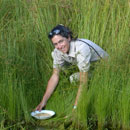 |
Holly B. Freifeld, Ph.D
Vertebrate Recovery Coordinator
U.S. Fish and Wildlife Service
Honolulu, Hawaii
Hawaiian petrel, Laysan duck, Mariana fruit bat,
and Newell’s shearwater
Dr. Holly Freifeld’s Recovery Champion award is the result of her exemplary contributions to the recovery of the Newell’s shearwater, Hawaiian petrel, Laysan duck, and Mariana fruit bat. Over the years, Freifeld has brought together diverse government agencies and non-government organizations to work towards the recovery of these endangered Pacific Island species. Her leadership ability in brokering close and significant working relationships with partners outside the Service while maintaining focus on significant recovery actions embodies the skills required to show success in recovering these severely imperiled species.
|
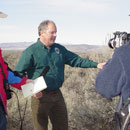 |
David Hays
Washington Department of Fish and Wildlife
Olympia, Washington
Columbia Basin pygmy rabbit
David Hays has made important contributions to the recovery of the Columbia Basin pygmy rabbit. Prior to the rabbit’s likely extirpation from the wild in 2004, he and his colleagues had the foresight to initiate a captive breeding program. These contributions have been critical to overcoming numerous challenges to a successful captive breeding program. Following the first release of captive-bred animals in March 2007, Hays continued to play a critical role in post-release monitoring and research to improve the reintroduction phase of recovery. Recovery efforts have involved a wide range of stakeholders and conservation partners, including internationally-recognized experts. Hays’ work has been central to achieving coordination among these diverse groups. |
| Region 2 |
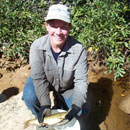 |
Shaula Hedwall
U.S. Fish and Wildlife Service
Flagstaff, Arizona
Chiricahua leopard frog
Through the results achieved in the face of non-native predators, disease, and drought, Shaula Hedwall has made exemplary contributions to the recovery of the Chiricahua leopard frog. She brought together diverse government agencies and non-government organizations for the benefit of this species. The rescue of the last remaining individuals of a unique subpopulation of the Chiricahua leopard frog occurred in large part due to Hedwall’s commitment to achieving a high level of cooperation among all stakeholders.
|
 |
Robert C. Sivinski
New Mexico State Forestry Division
Santa Fe, New Mexico
Kuenzler’s hedgehog cactus, Pecos sunflower,
Mesa Verde cactus, Sacramento Mountains thistle,
Zuni fleabane, and other imperiled plants
For more than eighteen years, Robert Sivinski has dedicated his efforts to the recovery of New Mexico’s imperiled plant species. His unique understanding of the complex issues surrounding the ecology and recovery of rare plants, as well as his positive working relationships with partners, has helped bring back from the brink of extinction many of the State’s plant species, including the Pecos sunflower, Kuenzler’s hedgehog cactus, Zuni fleabane, Sacramento Mountains thistle, and Mesa Verde cactus.
|
| Region 3 |
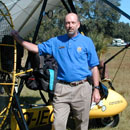 |
John Christian
U.S. Fish and Wildlife Service
Fort Snelling, Minnesota
Whooping crane
John Christian’s Recovery Champion award is based on his dedication to the recovery of the whooping crane. His tireless efforts have brought together a diverse group of partners to create an organization that has led a reintroduction and recovery effort for the crane. This endeavor has overseen raising young whooping cranes to providing intensive flight training at Necedah National Wildlife Refuge in Wisconsin, and through long and occasionally dangerous trips, leading the endangered birds to their wintering grounds in the Florida peninsula. These efforts have resulted in a substantial growth in the population of the species, including milestone events such as the first successful nesting and fledging of a whooping crane east of the Mississippi River in over 80 years.
|
 |
Douglas Bos
Rock County Land Management Office
Luverne, Minnesota
Topeka shiner
Douglas Bos is recognized for his contributions to the recovery of the Topeka shiner. His efforts have been instrumental in bringing county feedlots into compliance with the State’s feedlot rules, achieving reduced levels of runoff that are positively affecting the water quality and habitat of this endangered native fish. Bos’ leadership has brought together government agencies and private enterprises to leverage each partner’s efforts to achieve greater protection for the Topeka shiner and other aquatic species. It is in large part through his ability to attain this level of cooperation among all stakeholders that the Topeka shiner is coming back from the brink of extinction. |
| Region 4 |
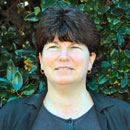 |
Sandra MacPherson
National Sea Turtle Coordinator
U.S. Fish and Wildlife Service
Jacksonville, Florida
Sea turtle species
As the Service’s National Sea Turtle Coordinator since 2000, Sandra MacPherson has served as a respected voice and major contributor to all substantive sea turtle conservation policies and management issues in the United States and its territories. While sea turtle conservation and recovery cannot be attributed to any one person, MacPherson has ensured that the Service provides strong, competent, and visible leadership. Her continuing efforts have enabled the leveraging of many partners’ efforts for the recovery of sea turtles throughout the southeastern United States, including Puerto Rico and the U.S. Virgin Islands.
|
 |
Gradi Morgan
Panama City, Florida
Florida’s sea turtles
As the owner of Rachel’s Lighting, Gradi Morgan has helped property owners and developers install sea turtle-friendly beach lighting, providing a model for ways that private citizens and business can make a positive difference for Florida’s endangered sea turtles. This initiative has improved conditions for nesting success for almost one quarter of all sea turtle nesting habitat in northwest Florida. Morgan’s work to educate others, her enthusiasm for sea turtles, and her willingness to provide lighting at a reasonable cost has allowed the Service, the State of Florida, and area partners to distribute information and make sea turtle lighting easily obtained by the general public.
|
| Region 5 |
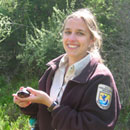 |
Robyn A. Niver
U.S. Fish and Wildlife Service
Cortland, New York
Bog turtle, Chittenango ovate amber snail,
Indiana bat, and Karner blue butterfly
Robyn Niver has made exemplary contributions to the recovery of federally-listed birds, bats, bog turtles, butterflies, and a variety of other listed wildlife. Of particular note are her efforts to champion the recovery of the extremely rare and imperiled Chittenango ovate ambersnail. This waterfall-dwelling snail has long been one of the Northeast Region’s most imperiled species. Although the snail’s status remains precarious, by revitalizing the recovery team, finding emergency funding, revising the recovery plan, and facilitating genetics research and new survey techniques, Niver’s work with Service colleagues, partners on the recovery team, and others has led to increased optimism about the fate of this species.
|

|
Mitchell Byrd, Ph.D and
Bryan Watts, Ph.D
Center for Conservation Biology
The College of William and Mary
Williamsburg, Virginia
Bald eagle
Few people have done as much as Dr. Mitchell Byrd and Dr. Bryan Watts to promote the recovery of the bald eagle. In 1991, they co-founded the Center for Conservation Biology at the College of William and Mary. In the ensuing 15 years, the Center conducted extensive research focused on gaining a better understanding of the ecology and life history of the bald eagle, and helped establish protected areas specifically for this species, such as the Mason Neck and James River National Wildlife Refuges. The Center for Conservation Biology has exemplified leadership in research, advocacy, partnership development, and habitat protection that has directly led to the recovery of the bald eagle, particularly in the Chesapeake Bay region. |
| Region 6 |
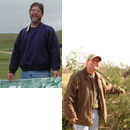 |
Nebraska Partners for Fish and Wildlife Program
Kenny Dinan, State Coordinator
Kirk Schroeder, Assistant State Coordinator
U.S. Fish and Wildlife Service
Grand Island, Nebraska
Least tern, pallid sturgeon, piping plover,
and whooping crane on the central Platte River
The Nebraska Partners for Fish and Wildlife Program has made important contributions to the recovery of whooping cranes, least terns, piping plovers, and pallid sturgeon on the central Platte River. The collective hard work of the Program has resulted in the restoration and enhancement of over 7,000 upland and wetland acres as well as nearly 50 miles of improved river habitat. Through tireless labor and extensive outreach efforts, the restoration of the central Platte has become a national model for success. The Program has brought together diverse government agencies, non-government organizations, landowners, and volunteers to work towards the recovery of several listed species as well as provided benefits to a range of native plants and animals.
|
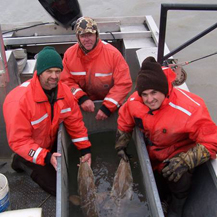 |
Missouri River Recovery Program
Threatened and Endangered Species Section
U.S. Army Corps of Engineers
Yankton, South Dakota
Least tern, pallid sturgeon, and piping plover
on the Missouri River
The Corps, through the Missouri River office, has made exemplary contributions towards the recovery of the least tern, piping plover, pallid sturgeon, and other species of the Missouri River. The Corps is successfully implementing one of the most comprehensive and geographically challenging endangered species monitoring and recovery programs ever conceived. Monitoring of more than 2,500 miles of reservoir shoreline and hundreds of river miles involves tremendous teamwork among a diverse group of biologists, summer employees, and other stakeholders. Activities include research and monitoring, habitat restoration, nest protection, weekly surveys of bird productivity, and captive propagation efforts. Also noteworthy is the implementation of an ambitious and comprehensive outreach program that engages all Missouri River basin stakeholders. |
| Region 7 |
 |
Nora Rojek
U.S. Fish and Wildlife Service
Fairbanks, Alaska
Steller’s eider
Since 2003, Nora Rojek has coordinated the Steller’s eider recovery project near Barrow, Alaska. In 2005, nesting was documented for the first time since 2000. Successful nests were also documented in 2006 and 2007. Under Rojek’s guidance, scientific knowledge of Steller’s eider breeding ecology has substantially advanced, and she has accomplished numerous high-priority tasks identified by the Steller’s Eider Recovery Team, including support for the Alaska SeaLife Center’s efforts to establish a captive breeding flock.
Rojek’s efforts have brought together diverse government agencies, non-government organizations, and individuals to work towards the recovery of the species. It is in large part through her ability to attain this level of cooperation among all stakeholders that the Steller’s eider is coming back from the brink of extinction.
|
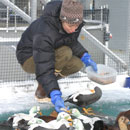 |
Tuula Hollmen, DVM
Alaska SeaLife Center
Seward, Alaska
Steller’s eider
With the support of a staff of technicians and animal husbandry experts, Dr. Tuula Hollmen is recognized for her management and leadership in Steller’s eider research and recovery projects. As manager of the Eider Program at the Alaska SeaLife Center, Hollmen has played a pivotal role in efforts to establish a captive flock of Steller’s eiders for use in future reintroduction plans. In addition, she has pioneered and collaborated on many other important eider recovery efforts, including a Reintroduction Feasibility Analysis to help determine whether to use reintroduction as a recovery tool for the species. Working with aviculturists from other regions and countries, as well as colleagues in the Service, Hollmen and staff have pioneered species-specific husbandry techniques. In 2007, the first Steller’s eider raised in captivity in North America, if not the world, was hatched at the Alaska SeaLife Center.
|
| Region 8 |
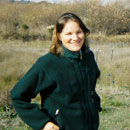 |
Kate Symonds
U.S. Fish and Wildlife Service
Sacramento, California
White sedge and other rare endemic plants
Kate Symonds has made significant contributions to the recovery of several extremely rare endemic plants. Her outreach efforts have enhanced local awareness and pride in these often overlooked species. As a representative of the Service’s Partners for Fish and Wildlife program, Symonds has led in the restoration of over 685 acres directed at the recovery of listed species. At least five projects on private lands host the last remaining population of five targeted species. Her ability to apply all available resources for these priority species has encouraged partners to “go the extra mile.” It is in large part through Symonds’ ability to achieve and sustain a high level of cooperation among all stakeholders that several of California’s endangered plant species are coming back from the brink of extinction.
|
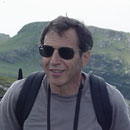 |
Gary Scoppettone
U.S. Geological Survey
Western Fisheries Research Center
Reno, Nevada
Borax Lake tui chub, Independence Valley
speckled dace, Moapa dace, White River
spinedace, and other aquatic species
Gary Scoppettone is one of a handful of scientists studying the status, distribution, life history, and habitat use of native desert fishes and other aquatic species in the Great Basin and Mojave deserts. His efforts over the last 30 years represent a critical link between research and on-the-ground management actions. Scoppettone has played a leadership role on a number of recovery teams and facilitated the cooperation of private and public partners. By the conservative estimates of his peers, he has also been instrumental in the hiring, training, and mentoring of dozens of research and agency biologists, many of whom are now conducting conservation programs throughout the United States. |
Information on 2006 Recovery Champions
For more information about our efforts to recover endangered and threatened species, please contact the Endangered Species' Recovery Program at your Regional Office of the U.S. Fish and Wildlife Service, or contact:
U.S. Fish and Wildlife Service
Branch of Recovery and Delisting
4401 N. Fairfax Drive, Room 420
Arlington, VA 22203
703-358-2061
|
















